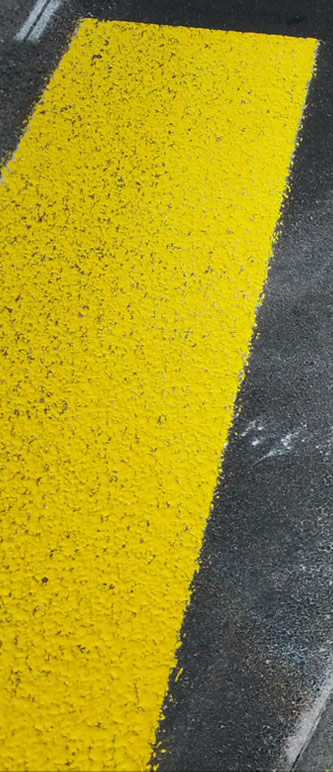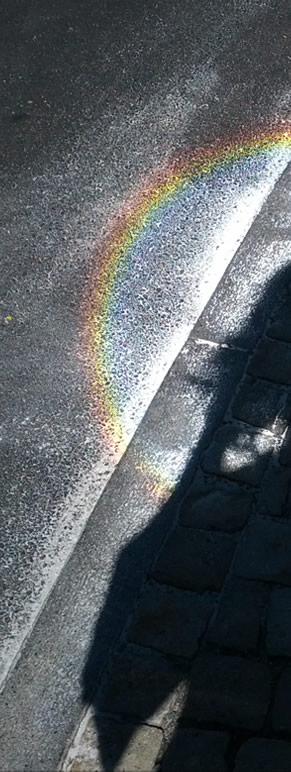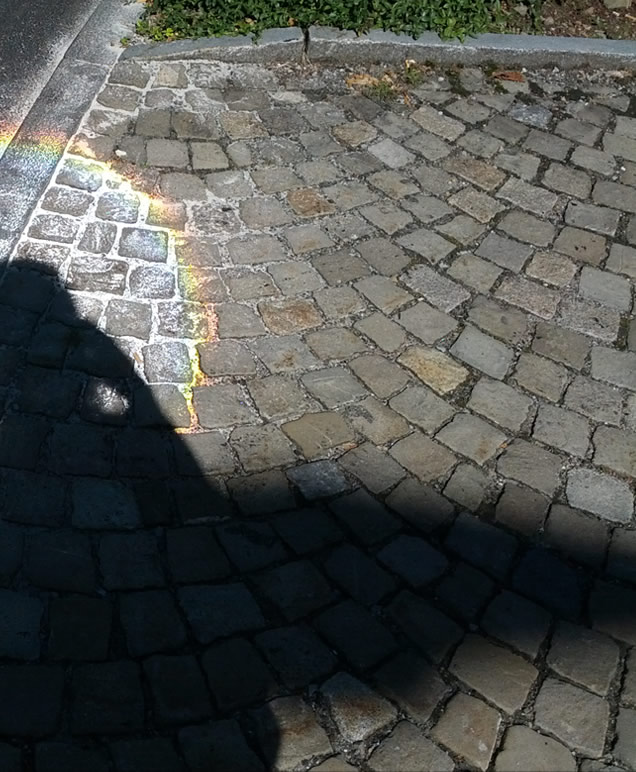Glass spheres make 'rainbows' in the same way as spherical raindrops. Light internally reflected once produces a primary bow. Its radius is only ~21° compared to the 42° of a water rainbow because glass refracts light more strongly than water. |
| How to make your own 'rainbow' Pawel Zuzelski of Poland caught this 'rainbow' on recently laid and painted asphalt. The bow is produced by tiny glass spheres sprinkled onto the road to enhance the reflectivity of the paint markings. Some of these spheres are ideal for making bright (and dry!) indoor bows. Image ©Pawel Zuzelski, shown with permission. |
Glass spheres make 'rainbows' in the same way as spherical raindrops. Light internally reflected once produces a primary bow. Its radius is only ~21° compared to the 42° of a water rainbow because glass refracts light more strongly than water. |
 |
 |
 |

| About - Submit | Optics Picture of the Day | Galleries | Previous | Next | Today |
| Recipes To make an indoor glass bead bow display you need to mount the beads evenly and smoothly on a board or cloth. Then it should be illuminated by very bright and small light. Here are two approaches: Robert Greenler, author of the classic book "Rainbows Halos and Glories", has sent this account for OPOD readers: "...The glass-bead display can be made to work more easily [than an indoor water spray]. The glass beads used in road markings will work well. I have used "spray adhesive" to attach them to either black cardboard or cloth. The adhesive comes in aerosol spray cans and is available from several manufacturers. I spray the surface in an east-west pattern and then in a north-south pattern to get complete coverage and then sprinkle the glass beads over the surface with a big salt shaker. if you tilt the surface in different directions before the adhesive dries you can roll the loose beads around to make the coverage more uniform. At one time I used a bead-coated cloth of dimension 3 meter x 3 meter in the front of a lecture room that seated 250 people. To show the rainbow to people in different parts of the room I walked across the front of the room--between the screen and the audience--with a light that illuminated the entire screen. People who were on a line between me and the screen could see the bow. How close the source should be to the screen depends on how far away the observer is--and can be determined by trial. The light that I used was a replacement bulb (with the build-in reflector) for a 35 mm slide projector. Here 35 mm slide projectors are now an endangered species. Another (more hands-on) very simple demo consists of a shallow box (perhaps 30 cm on a side) with a black bottom, and a clear plastic top. Put in some of the glass beads and tape up all of the seams so that the beads can't be spilled from the box. Shake the box to distribute the beads across the bottom and view the beads with a small light source held between observer and box. The light source that I used was the bare bulb of a small "Maglite" flashlight. Now you would probably use an LED. You want a single small source, without a back reflector. Whatever the arrangement you want the light from the source to illuminate the entire layers of beads. You want to let the viewer play with the light and move it toward and away from the surface to see the rainbow change in size. I think the "participation" is necessary to make this demo interesting. At a table you could have several of these boxes and lights to accommodate several viewers at the same time. There are subtleties to both of the demos [water drops and glass beads]: In Nature's rainbow, the light source is at a great distance, with the result that the angular size of the rainbow does not change with the distance of the raindrops from the observer; the angular size of a rainbow in the spray of a hand-held hose is the same as that produced by a sheet of rain a kilometer away. In these [glass bead] demos, with the light source between observer and beads, the angular size of bow does vary with distance. Good luck with your efforts." Charles Monkhouse has produced impressive artwork (1,2,3) employing glass bead bows and offers this advice: "In the end [to mount the beads] we settled for 3M Photo Mount. It's worked for this exhibition over a couple of weeks but I noticed that in the stuff I did earlier in the summer the glass beads had dulled. We had to scraped them off and start again. So ultimately we are also looking for a more permanent solution. But if a few weeks will suffice this was the process: Paint with matte black emulsion Spray with spray mount as per instruction on tin Sprinkle on beads (tricky getting an even surface - we used a couple of sieves inside each other with gaffer tape between to control the flow, and then poured the beads from a mug, into the sieve while shaking) Leave an hour. Tip up and shake off surplus. Repeat with another layer of Photo Mount and beads. Shake again and hang. Don't let anybody touch the surface! We used the spray liberally - 10 cans over 15 sq meters. Incidentally we used 650w Fresnel spots for the studies and a 2000w profile spot for the Rood screen." Glass beads can be begged from a local road repair depot or ordered direct from manufacturers. Do check their quality before investing bow-making effort. For illumination, try a small bright halogen bulb for the close-up experiemnts that Robert Greenler suggests. More distant light sources should be small and very bright indeed. Patience and experiments are needed but the rewards of your own indoor rainbow, especially those from a nearby hand-held lamp are great. Contrary to the oft quoted (and misquoted) Lamia poem of Mr Keats, "unweaving (and having your own tame) rainbow" does not destroy the charms of those of the sky nor dim them with cold philosophy. Rather it deepens our awe, appreciation and understanding of Nature's wonders. Make a bow today! |